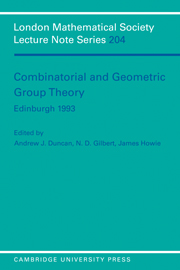Book contents
- Frontmatter
- Contents
- Foreword
- Participants
- On bounded languages and the geometry of nilpotent groups
- Finitely presented groups and the finite generation of exterior powers
- Semigroup presentations and minimal ideals
- Generalised trees and Λ-trees
- The mathematician who had little wisdom: a story and some mathematics
- Palindromic automorphisms of free groups
- A Freiheitssatz for certain one-relator amalgamated products
- Isoperimetric functions of groups and exotic cohomology
- Some embedding theorems and undecidability questions for groups
- Some results on bounded cohomology
- On perfect subgroups of one-relator groups
- Weight tests and hyperbolic groups
- A non-residually finite, relatively finitely presented group in the variety N2A
- Hierarchical decompositions, generalized Tate cohomology, and groups of type (FP)∞
- Tree-lattices and lattices in Lie groups
- Generalisations of Fibonacci numbers, groups and manifolds
- Knotted surfaces in the 4-sphere with no minimal Seifert manifolds
- The higher geometric invariants of modules over Noetherian group rings
- On calculation of width in free groups
- Hilbert modular groups and isoperimetric inequalities
- On systems of equations in free groups
- Cogrowth and essentiality in groups and algebras
- Regular geodesic languages for 2-step nilpotent groups
- Finding indivisible Nielsen paths for a train track map
- More on Burnside's problem
- Problem Session
Weight tests and hyperbolic groups
Published online by Cambridge University Press: 05 April 2013
- Frontmatter
- Contents
- Foreword
- Participants
- On bounded languages and the geometry of nilpotent groups
- Finitely presented groups and the finite generation of exterior powers
- Semigroup presentations and minimal ideals
- Generalised trees and Λ-trees
- The mathematician who had little wisdom: a story and some mathematics
- Palindromic automorphisms of free groups
- A Freiheitssatz for certain one-relator amalgamated products
- Isoperimetric functions of groups and exotic cohomology
- Some embedding theorems and undecidability questions for groups
- Some results on bounded cohomology
- On perfect subgroups of one-relator groups
- Weight tests and hyperbolic groups
- A non-residually finite, relatively finitely presented group in the variety N2A
- Hierarchical decompositions, generalized Tate cohomology, and groups of type (FP)∞
- Tree-lattices and lattices in Lie groups
- Generalisations of Fibonacci numbers, groups and manifolds
- Knotted surfaces in the 4-sphere with no minimal Seifert manifolds
- The higher geometric invariants of modules over Noetherian group rings
- On calculation of width in free groups
- Hilbert modular groups and isoperimetric inequalities
- On systems of equations in free groups
- Cogrowth and essentiality in groups and algebras
- Regular geodesic languages for 2-step nilpotent groups
- Finding indivisible Nielsen paths for a train track map
- More on Burnside's problem
- Problem Session
Summary
Abstract
The notion of reduced diagram plays a fundamental role in small cancellation theory and in tests for detecting the asphericity of 2-complexes. By introducing vertex reduced as a stricter form of reducedness in diagrams we obtain a new combinatorial notion of asphericity for 2-complexes, called vertex asphericity, which generalizes diagrammatic reducibility and implies diagrammatic asphericity. This leads to a generalization and simplification in applying the weight test [2] and the cycle test [6] [7] to detect asphericity of 2-complexes and (for the hyperbolic versions of these tests) to detect hyperbolic group presentations. In the end, we present an application to labeled oriented graphs. We would like to thank the referee for his helpful suggestions.
Basic Definitions
A p.l. map between 2-complexes is called combinatorial, if each open cell is mapped homeomorphically onto its image. A 2-dimensional finite CW-complex is called combinatorial, if the attaching maps of the 2-cells are combinatorial relative to a suitable polygonal subdivision of their boundary.
Let KP be the standard 2-complex of the presentation P (we assume all presentations to be finite). A diagram is a combinatorial map f: M → KP, where M is a combinatorial subcomplex of an orientable 2-manifold. A spherical diagram is a diagram f:S → KP, where S is the 2-sphere. These definitions may be found for example in [1], [2], [6], [7] or [8].
- Type
- Chapter
- Information
- Combinatorial and Geometric Group Theory, Edinburgh 1993 , pp. 174 - 183Publisher: Cambridge University PressPrint publication year: 1994
- 2
- Cited by



